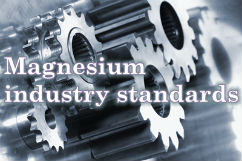 Magnesium
Magnesium- Magnesium, a grayish-white and fairly tough metal, is a chemical element with the symbol Mg and atomic number 12.It is an alkaline earth metal in Group II in the periodic table and the eighth most abundant element in the Earth's crust-although not found in its elemental form-and ninth in the known universe as a whole. Magnesium is the fourth most common element in the Earth as a whole, making up 13% of the planet's mass and a large fraction of the planet's mantle. Due to magnesium ion's high solubility in water, it is the third most abundant element dissolved in seawater. Magnesium metal burns with a very bright light. Magnesium can be used to remove sulfur from iron and steel. Magnesium compounds, primarily magnesium oxide, are used mainly as refractory material in furnace linings for producing iron and steel, nonferrous metals, glass, and cement. Magnesium alloys are used as structural components of automobiles and machinery.
Magnesium is the fourth most common element in the Earth as a whole (behind iron, oxygen and silicon).

- Magnesium: history and industry development
- Studies are still continuing when it comes to magnesium and its possible applications. However, it all began with its discovery, which can be credited to three individuals, as each chemist is associated with a major breakthrough...

- Magnesium uses
- Magnesium is the lightest of all light metal alloys and therefore is an excellent choice for engineering applications when weight is a critical design element. It is strong, has good heat dissipation, good damping and is readily available...

- Magnesium: extraction
- Magnesium is found in solution in sea-water (about 1.3 kg m-3 magnesium) and in natural brines. It is also found extensively in the ores magnesite (MgCO3) and dolomite (MgCO3.CaCO3). Both of the two types of resources can be used as raw materials to manufacture magnesium metal...

- Magnesium: effects on human health
- Magnesium is an essential mineral required by the body for maintaining normal muscle and nerve function, preserving a healthy immune system, maintaining heart rhythm and building strong bones...

- Magnesium: industry standards
- ASTM B953-13 Standard Practice for Sampling Magnesium and Magnesium Alloys for Spectrochemical Analysis; ASTM B954-07 Standard Test Method for Analysis of Magnesium and Magnesium Alloys by Atomic Emission Spectrometry...

- Magnesium industry news
- 1.Simple substitution cuts solar cell toxicity A cheap chemical used to make bath salts and tofu looks to be the solution to cutting toxic cadmium from a promising type of solar cell. Magnesium chloride can be used in place of poisonous cadmium chloride in thin film solar cells without the need to change the fabrication process...
- Contents
- References
- 1. Expert Group on Vitamins and Minerals 2003
- 2. MAGNESIUM - Non-ferrous Metals - Metals and Minerals Knowledge Series - SearchMining.net Mining Info
- 3. International Magnesium Association (IMA): Welcome
- 4. Mineral Resources International P.O. Box 190 • Roy, UT 84067 • USA
- 5. Magnesium
- 6. Dietary Requirements
- 7. Simple substitution cuts solar cell toxicity | Chemistry World
- 8. Development of the world's strongest magnesium alloy



